Procedure For Renew Propeller on ship
How to Measure Cylinder Liner Bore Wear on ship?
Types of Mechanical Measuring Tools and Gauges Used on Ships
what type of propeller used on ship? Controllable Pitch Propeller (CPP) Vs Fixed Pitch Propeller (FPP)?
Machinery onboard ships require regular care and maintenance so that their working life and efficiency can be increased, and the cost of operation, which includes unnecessary breakdowns and spares, can be reduced. For different types of machinery and systems, various measuring tools, instruments and gauges are used on a ship.
How to Measure Cylinder Liner Bore Wear on ship?
Types of Mechanical Measuring Tools and Gauges Used on Ships
what type of propeller used on ship? Controllable Pitch Propeller (CPP) Vs Fixed Pitch Propeller (FPP)?
Machinery onboard ships require regular care and maintenance so that their working life and efficiency can be increased, and the cost of operation, which includes unnecessary breakdowns and spares, can be reduced. For different types of machinery and systems, various measuring tools, instruments and gauges are used on a ship.
Measuring instruments and gauges are used to measure various parameters such as clearance, diameter, depth, oval... These are critical engineering parameters, which describe the condition of the working machinery.
Popular mechanical gauges and tools used on ships are:
Ruler and scales
They are used to measure lengths and other geometrical parameters. They can be a single steel plate or flexible tape type tool.
Calipers
They are usually of two types- inside and outside caliper. They are used to measure internal and external size (for e.g. diameter) of an object. It requires external scale to compare the measured value.
Some calipers are integrated with measuring scale. Other types are odd leg and divider caliper.
Vernier caliper
It is a precision tool used to measure a small distance with high accuracy. It has got two different jaws to measure outside and inside dimension of an object.It can be a scale, dial or digital type vernier caliper.
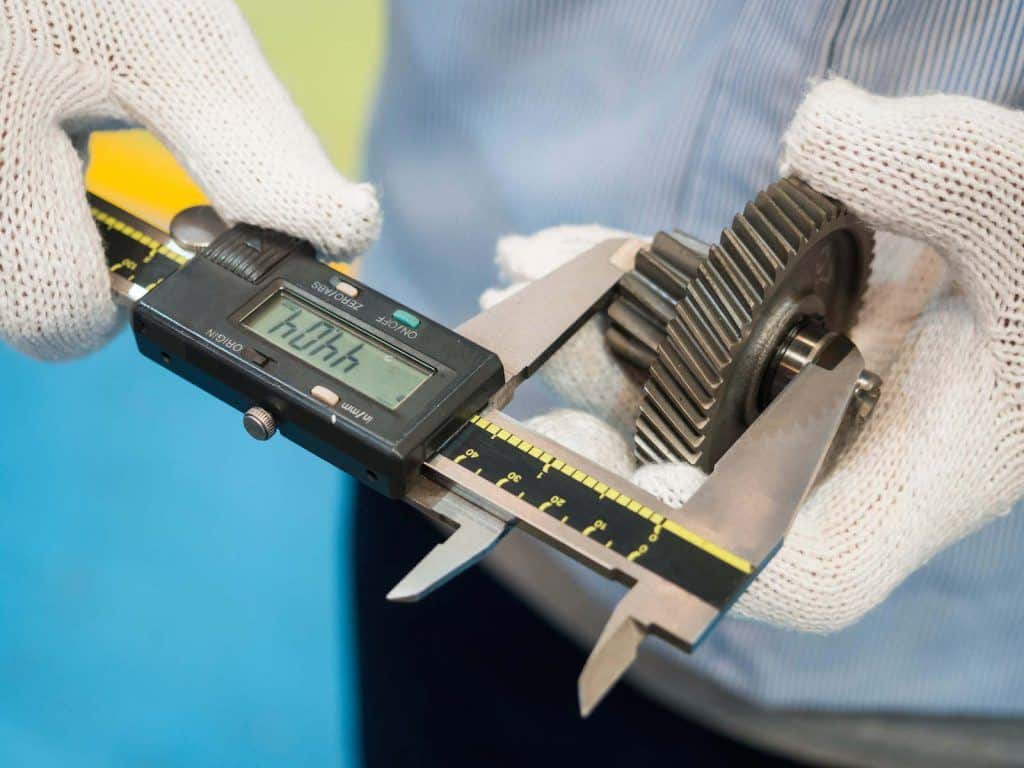
Micrometer
It is an excellent precision tool which is used to measure small distances and is more accurate than the vernier caliper. Another type is a large micrometer caliper which is used to measure large outside diameter or distance.

They are available in two types- Inside micrometer (to measure inside diameter) and Outside micrometer (for measuring outside diameter)
Feeler gauge
Feelers gauges are a bunch of fine thickened steel strips with a marked thickness which is used to measure gap width or clearance between surface and bearings.
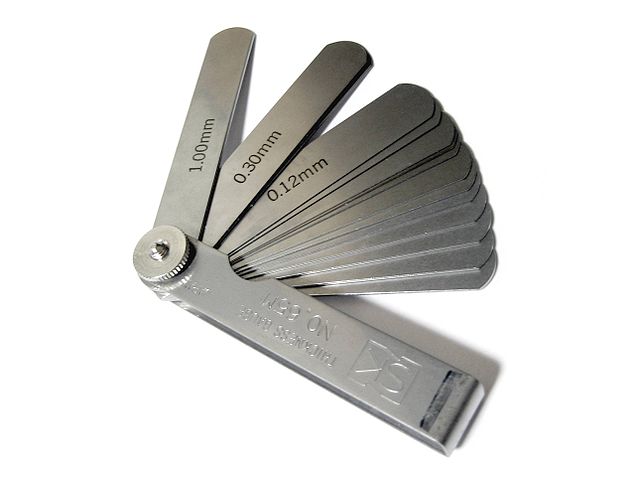
Telescopic feeler gauge
It is also known as tongue gauge, and it consists of long feeler gauge inside a cover with tongue or curved edge.
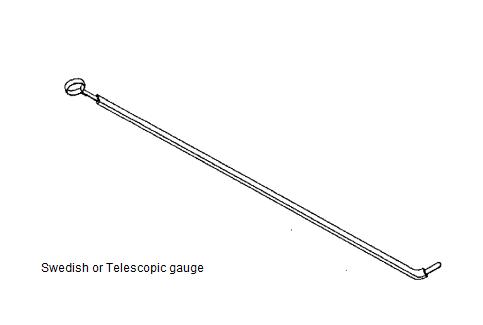 The long feeler strips protrude out of the cover so that it can be inserted into remote places where feeler gauge access is not possible.
The long feeler strips protrude out of the cover so that it can be inserted into remote places where feeler gauge access is not possible.

Poker gauge
This gauge is used to measure propeller stern shaft clearance, also known as propeller wear down
Bridge gauge
Bridge gauges are used to measure the amount of wear of Main engine bearing. Typically the upper bearing keep is removed, and clearance is measured for the journal.
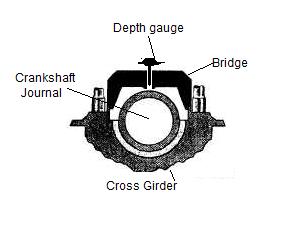 A feeler gauge or depth gauge can be used to complete the process.
A feeler gauge or depth gauge can be used to complete the process.

Liner measurement tool
Liner measurement tool is a set of the straight assembled rod with marked length in each set. It is used to measure the wear down or increase the diameter of the engine liner.
American Wire Gauge
American wire gauge or AWG is a standard tool which is circular and has various slots of different diameter in its circumference. It is used to measure the cross section of an electric cable or wire.

Source: Wikimedia

Source: Wikimedia
Bore Gauge
A tool to accurately measure the size of any hole is known as bore gauge, It can be a scale, dial or digital type instrument.


Depth gauge
A depth gauge is used to measure the depth of a slot, hole or any other surface of an object. It can be of scale, dial or digital type.
Angle plate or tool
It is a right angle plate or device used to measure the exact right angle of two objects joined together.


Flat plate
the flat plate is a precision flat surface used to measure the flatness of an object when it is kept over the flat plate.


Dial Gauge
The dial gauge is utilized in different tools as stated above and can be separately used to measure the trueness of the circular object, jumping off an object, etc.

Source: Wikimedia/Solaris2006

Source: Wikimedia/Solaris2006
Lead Wire
It is a conventional method to used soft lead wire or lead balls to measure the wear down or clearance between two mating surfaces. The lead wire or balls of fixed dimension are kept between two surfaces, and both are tightened against each just as in normal condition. The increase in the width of the lead wire or ball will show the clearance or wear down.
Oil Gauging tapes
Also known as sounding tapes, these are used to measure the level of the fluid (HFO, DO, Lubes, Water etc.) inside the ship’s tanks
Seawater Hydrometer
A small glass instrument for measuring the density and saturation of the salt in the seawater
Crankshaft deflection gauge
A form of dial gauge specifically made to measure the crankshaft deflection of the marine engine.
Engine peak indicator
A measuring instrument for a marine engine with pressure indicator dial used to measure the peak pressure generated inside the engine cylinder.
Engine Indicator diagram tool
It is a cylindrical device with spring and needle, used to draw the indicator diagram for a particular cylinder when it is fixed on the indicator cock of the unit.
Planimeter
An instrument which is used to measure areas of irregularly shaped areas of an arbitrary two-dimensional shape on plans or drawings.


 RSS Feed
RSS Feed Twitter
Twitter 1:54 AM
1:54 AM
 Around the world
Around the world
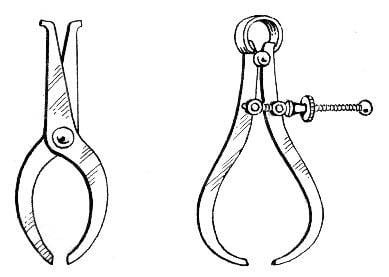
 Posted in
Posted in 









2 comments:
I really appreciate this stuff.it is very amazing content.thanks for sharing such a useful stuff.it really helped me very much to solve many proble.
EFA Course
Doosan Machine tools of VX 6500G and VX 6500C, Vertical Machining Centers for High-exactness Graphite and Ceramic Processing
measuring news
Post a Comment